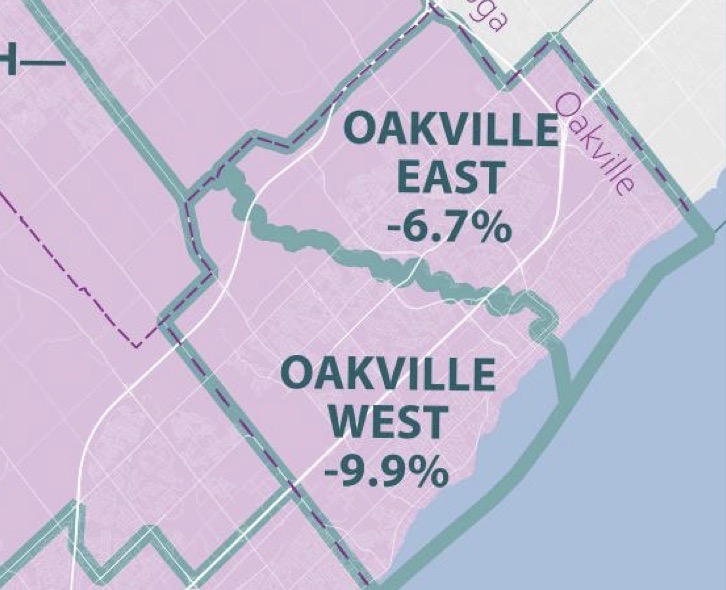Future federal elections will see Oakville voters cast their ballots in new ridings.
The Federal Electoral Boundary Commission is recommending the creation of two new ridings – Oakville East and Oakville West – to replace existing political districts.
The changes come as a result of the latest census data, which is expanding the House of Commons by five seats, with Ontario gaining one of those ridings.
The process of reshaping electoral ridings is now in its final stages.
Oakville’s current two ridings divide the town between the older southern portion and the newer northern section, primarily along Upper Middle Road.
The southern Oakville riding is currently held federally by Liberal Anita Anand and provincially by Progressive Conservative Stephen Crawford.
The riding of Oakville North – Burlington, held federally by Liberal Pam Damoff and provincially by Progressive Conservative Effie Triantafilopoulos, represents north Oakville and north Burlington voters.
The new east-west ridings will be created by dividing the town in half along the Sixteen Mile Creek to create two roughly equal-sized blocks.

In 2021, Oakville East had 108,735 people, while Oakville West had 105,024.
The commission aimed to create ridings with populations within 10 per cent of 116,590. While the two Oakville ridings are currently 6.7 and 9.9 per cent below that size, significant growth is planned for the town.
“Sixteen Mile Creek serves as a clear natural boundary that divides the town neatly in half,” notes the commission’s report.
It adds that the new ridings provide “a better blending of differential north-south population growth” and “are more socioeconomically balanced.”
The proposed new ridings were recommended by Oakville’s town council after it formally registered its opposition to an initial plan to divide the town up among three ridings that would have included areas of Burlington, Milton and Georgetown.
“We advised the commission to consider electoral boundaries that better reflect the interests of Oakville residents,” said a statement from Mayor Rob Burton.
“And we are pleased that our suggestion for an east-west pairing of ridings in Oakville was taken into account and included in the report that was tabled in the House of Commons.”
One set of issues
The new ridings will be helpful in ensuring all of the town’s issues get attention from both political representatives, says long-time politician Kevin Flynn, who served as Oakville MPP from 2003 to 2018.
The current north-south alignment of the ridings makes them quite dissimilar, with distinct concerns arising from the different demographics and development styles.
But with the creek as a dividing line, the town’s two ridings will suddenly become much more similar.
“A north-south divide would have meant one rep would deal with the older challenges and lake-based issues, while the other would be dealing with insufficient schooling, transit and increasing crime prevention measures, for example,” said Flynn.
“It is obviously better for the community that two of their reps are dealing with one set of issues.”
Provincially, Flynn believes the Oakville ridings will “remain a two-horse race between the Liberals and Progressive Conservatives.”
"Door knocking's not going to be easy"
Kerry Colborne, who ran as the Conservative candidate in the Oakville riding in the 2021 federal election, says she believes the QEW is more of a natural boundary in the town than the creek.
But she says the two new ridings will be inclusive and will see a north-south sharing of power new to the town’s political dynamic.
Colborne says managing a campaign across the geographically unwieldy ridings will be challenging from a political perspective. “Door knocking’s not going to be easy, that’s for sure.”
She said she would seek election in Oakville East, as she lives in that riding and thinks it’s important to people that their political representatives reside where they run.
Damoff, who served as a town councillor for Ward 2 on the west side of the creek until her 2015 federal election, told Oakville News that she would look to run in the Oakville West riding.
But Anand wouldn’t commit her plans, saying only, “I love all of Oakville.”
“We are pleased by indications that the Town of Oakville will now have two exclusively dedicated federal representatives in Parliament,” said a joint statement from Damoff and Anand.
Recommendations from the commission are before the House of Commons for comment, with the commission having the final say on electoral boundaries.
The process is intended to be politically neutral to avoid partisan manipulation of ridings – or gerrymandering – as seen in some areas of the United States.
New federal ridings will be used in the next election as long as they are in place at least seven months before the election is called.
Ontario is expected to adopt the changes and revise provincial riding boundaries to match.